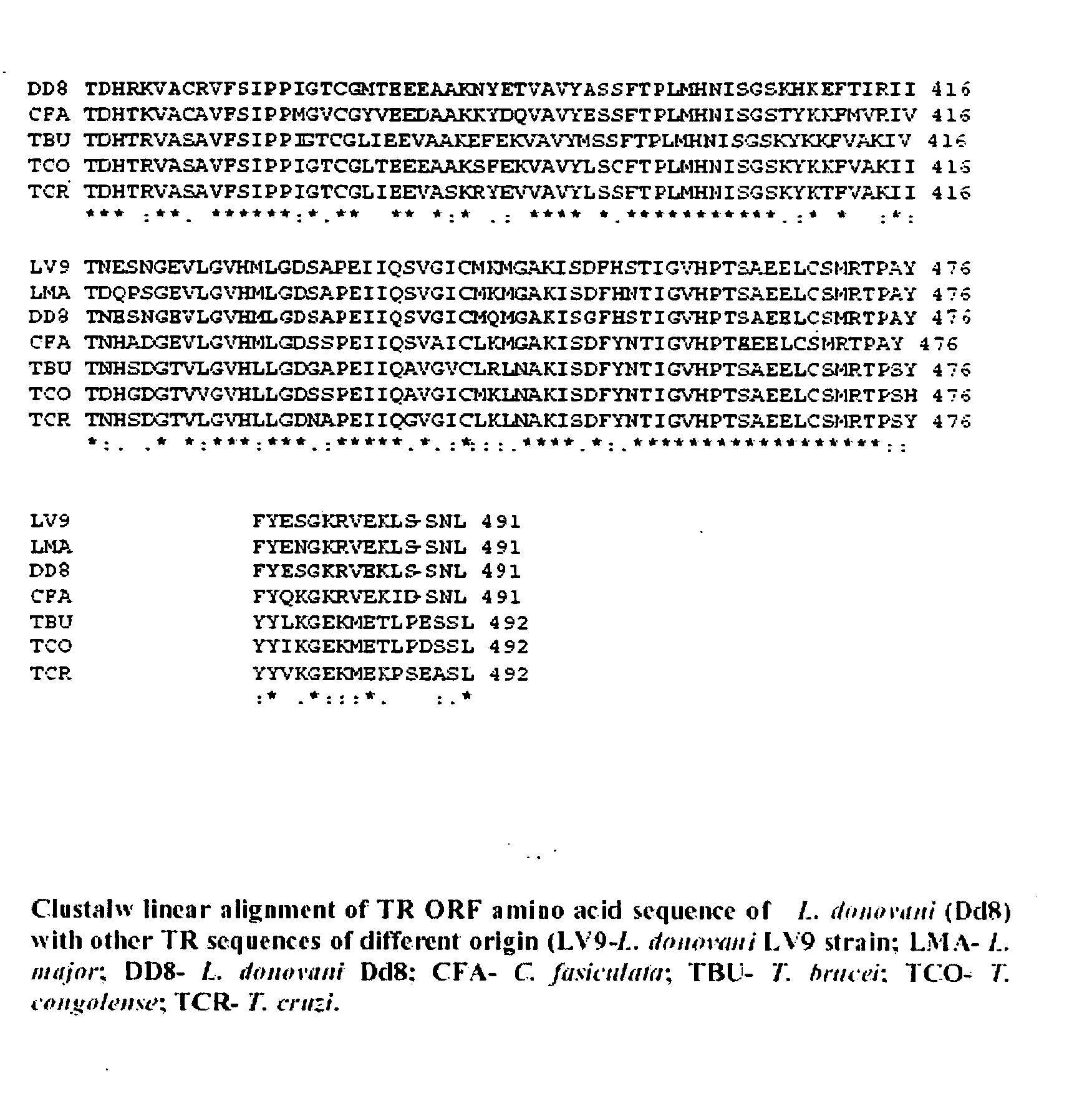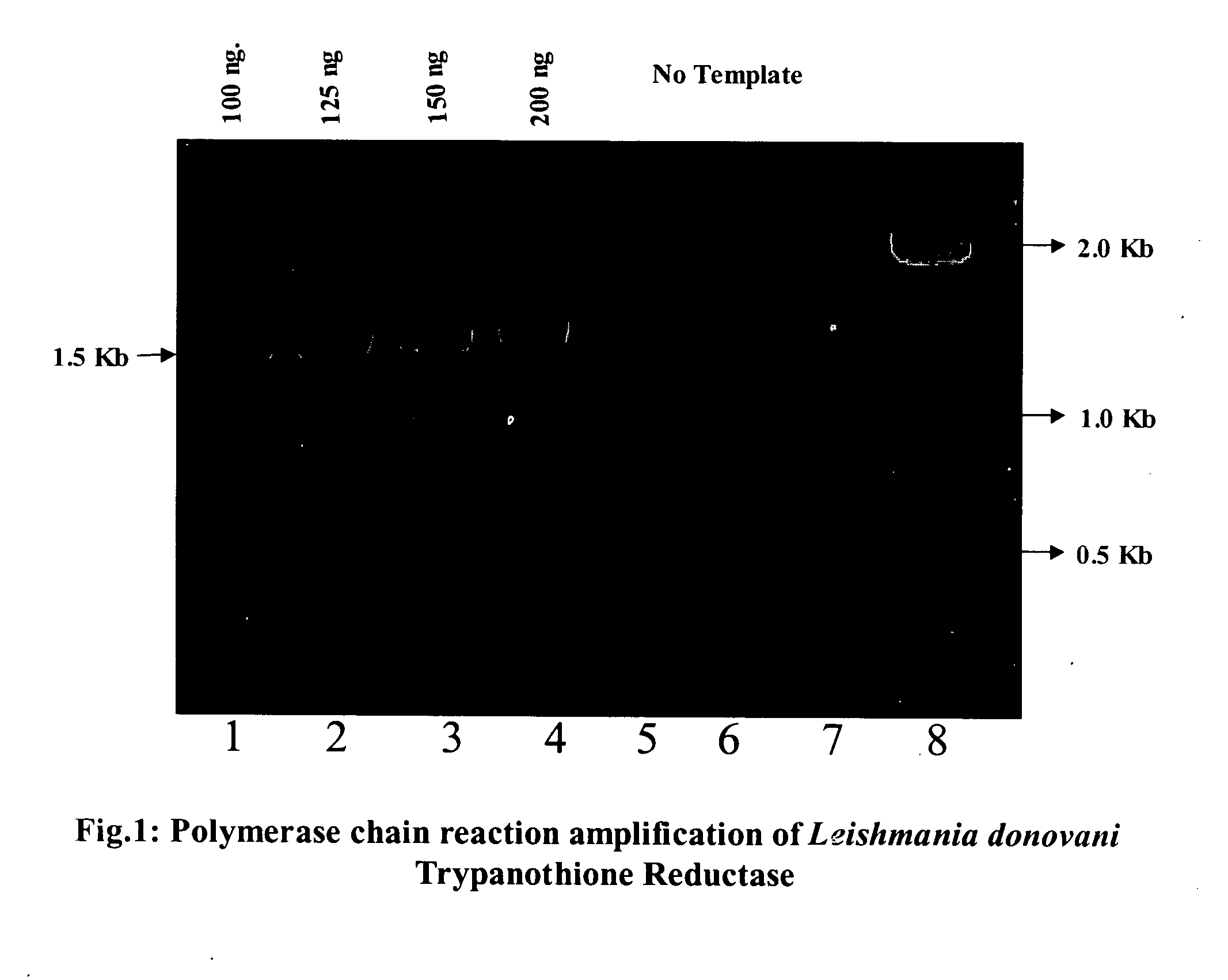Heterologus expression of trypanothione reductase from Leishmania donovani in a prokaryotic system
a technology of trypanothione reductase and heterologous expression, which is applied in the field of heterologous expression and large-scale production of the functionally active enzyme trypanothione reductase of leishmania donovani in the prokaryotic system, can solve the problems of increasing the non-responsiveness to sag, requiring a lot of laboratory work, and requiring a long time to obtain active protein from inclusion bodies, so as to achieve a high yield
- Summary
- Abstract
- Description
- Claims
- Application Information
AI Technical Summary
Benefits of technology
Problems solved by technology
Method used
Image
Examples
example 1
Cloning and Sequencing of TR of Leishmania donovani Dd8 Strain
Cloning and Sequencing:
[0098] Trypanothione reductase (TR) gene is a single copy gene in Leishmanial genome and is located on a 1.1 MB chromosome (23). Complete Open reading frame of the said protein was amplified using genomic DNA (100-200 ng / reaction) as a template and primers designed from known sequences flanking the TR ORF. The template DNA was initially denatured at 94° C. for 6-9 min. then allow to amplify using 25-30 cycles at 95° C. / 1-2 min., 45-47° C. / 1 min. and 72° C. / 2-3 min. The purified PCR product was cloned in any TA cloning vector like TOPOII vector (Invitrogen), pGEM-T (Promega) and TA cloning vector of Stratagene. The plasmid was then transformed and propagated in suitable E.coli competent cells. In total 5-7 clones were sequenced using dideoxy method (Sanger et al) in both direction to confirm the sequence of the amplicon and a 1508 nucleotide long ORF was submitted in EMBL genesequence (AJ415162). ...
example 2
Heterologous Expression of LDdTR in E.coli
Expression and Purification:
[0101] A single colony of E.coli containing LdTRORF was inoculated in to 5-10 ml LB medium with ampicilline (75-100 μg / ml) and kanamycin (50-100 μg / ml) and allowed to grow at 22-37° C. overnight. The overnight grown culture was then transferred to 100 ml LB in 1:50 or 1:100 ratios containing ampicilline (50-100 μg / ml) and kanamycin (50-100 μg / ml) and incubated further at 20° C.-35° C. The culture was grown to the culture density of (O.D.)600=0.5-0.8 and induced with 0.1-2 mM IPTG and then incubated at 20-28° C. for 6-18 hrs. The cells were harvested by centrifugation at 3000-5000 rpm for 20 min at 4° C. The wet cell pellet was suspended into 20 ml of lysis buffer (10 mM K+Po4− buffer pH 7.2, 10 mM EDTA, 0.01% tritonX100, 0.1 mM PMSF) and sonicated with a power at 50 W (3-5 times 30 sec to 1 min. pulse with 1-2 minute cooling interval). The cell homogenate was centrifuged at gravitational force 9000-12000 g for ...
example 3
Purification
[0104] Single clone LddTRpET41aDE3 was inoculated in 10 ml LB medium with kanamycin (50 μg / ml) at 25° C. overnight. The overnight grown culture was then transferred to 100 ml LB in 1:100 ratio containing 50 μg / ml kanamycin and incubated further at 22° C. and 200 rpm. The culture was grown upto the (O.D.)600=0.4-0.5 and induced with 1 mM IPTG (isopropyl-D-thiogalactopyranoside) and further incubated at 22° C. overnight at 200 rpm. The cells were harvested by centrifugation at 6000 rpm for 20 min. The wet cell pellet was either stored at −20° C. or suspended into 20 ml of lysis buffer (10 mM K+Po4− buffer pH 7.2, 10 mM EDTA, 0.01% tritonX100, 0.1 mM PMSF) and sonicated with a power at 50 W (six times thirty sec. pulse with one minute interval). The cell homogenate was centrifuged at 12000 g for 20 min. After removing debris clear supernatant (20 ml) was loaded to a pre-equilibrated resin (5×washed with 10 ml and re-suspended in 8 ml of 10 mM Potassium phosphate buffer pH ...
PUM
| Property | Measurement | Unit |
|---|---|---|
| temperature | aaaaa | aaaaa |
| pH | aaaaa | aaaaa |
| pH | aaaaa | aaaaa |
Abstract
Description
Claims
Application Information
 Login to View More
Login to View More - Generate Ideas
- Intellectual Property
- Life Sciences
- Materials
- Tech Scout
- Unparalleled Data Quality
- Higher Quality Content
- 60% Fewer Hallucinations
Browse by: Latest US Patents, China's latest patents, Technical Efficacy Thesaurus, Application Domain, Technology Topic, Popular Technical Reports.
© 2025 PatSnap. All rights reserved.Legal|Privacy policy|Modern Slavery Act Transparency Statement|Sitemap|About US| Contact US: help@patsnap.com



